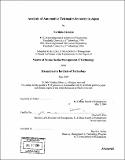| dc.contributor.advisor | Charles H. Fine. | en_US |
| dc.contributor.author | Shimizu, Norihito, 1971- | en_US |
| dc.contributor.other | Massachusetts Institute of Technology. Management of Technology Program. | en_US |
| dc.date.accessioned | 2005-06-02T19:01:57Z | |
| dc.date.available | 2005-06-02T19:01:57Z | |
| dc.date.copyright | 2004 | en_US |
| dc.date.issued | 2004 | en_US |
| dc.identifier.uri | http://hdl.handle.net/1721.1/17879 | |
| dc.description | Thesis (S.M.M.O.T.)--Massachusetts Institute of Technology, Sloan School of Management, Management of Technology Program, 2004. | en_US |
| dc.description | Includes bibliographical references (leaves 65-66). | en_US |
| dc.description.abstract | A major element of mobile multimedia, telematics is the convergence of telecommunication and information technology which provides various services to and from the vehicle or mobile communication devices. Telematics is also a new technology which accelerates the rate of technological evolution in the automotive electronics industry. Similar to the United States and Europe, Japan is one of the nations which have advanced automotive technologies. Japanese telematics, however, doesn't have a long history. On the other hand, Japan has unique business circumstances such as highly developed mobile communication technology and contents business. The purpose of this study is to unlock the industrial structure and dynamics of the telematics industry in Japan. In addition, providing indications for building business strategies for telematics players such as automakers, auto suppliers and other industries is another objective. According to the "clockspeed" analysis, telematics clockspeed is much faster than that of automobiles. This situation creates a boundary called clockspeed collision between these two industries. Clockspeed collision will increase market pressure on automakers to provide updated electronic features and to reduce exposure of obsolescence. Clockspeed collision will also significantly affect the business strategies that each player involved in the telematics industry must consider. Value chain analysis illustrates that the telematics industry has a horizontally disintegrated structure. Also the fact that automakers have advantages in the industry is presented. In such situation, the "business double helix" explains that automakers' advantages will be unstable in the future. Namely, the supplier sector in the industry will have significant | en_US |
| dc.description.abstract | (cont.) power. My research shows that telematics industry has already started to move toward a much more vertically integrated structure. These analyses lead to conclusions that each player in the telematics industry must recognize a principle of temporary advantage and that the automotive industry is moving from automobile production to maximizing customer's LTV (Life Time Value). | en_US |
| dc.description.statementofresponsibility | by Norihito Shimizu. | en_US |
| dc.format.extent | 66 leaves | en_US |
| dc.format.extent | 2895354 bytes | |
| dc.format.extent | 2900550 bytes | |
| dc.format.mimetype | application/pdf | |
| dc.format.mimetype | application/pdf | |
| dc.language.iso | eng | en_US |
| dc.publisher | Massachusetts Institute of Technology | en_US |
| dc.rights | M.I.T. theses are protected by copyright. They may be viewed from this source for any purpose, but reproduction or distribution in any format is prohibited without written permission. See provided URL for inquiries about permission. | en_US |
| dc.rights.uri | http://dspace.mit.edu/handle/1721.1/7582 | |
| dc.subject | Management of Technology Program. | en_US |
| dc.title | Analysis of automotive telematics industry in Japan | en_US |
| dc.type | Thesis | en_US |
| dc.description.degree | S.M.M.O.T. | en_US |
| dc.contributor.department | Management of Technology Program. | en_US |
| dc.contributor.department | Sloan School of Management | |
| dc.identifier.oclc | 56628999 | en_US |
